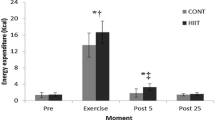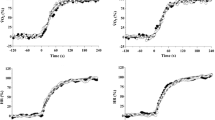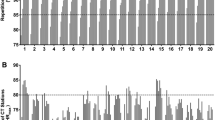Abstract
Purpose
The aim of this study was to compare the effects of low-volume, high-intensity aerobic interval training (HAIT) on maximal oxygen consumption (\(\dot{V}\)O2max), left ventricular (LV) mass, and heart rate recovery (HRR) with high-volume, moderate-intensity continuous aerobic training (CAT) in sedentary adults.
Methods
Twenty-four healthy but sedentary male adults (aged 29.2 ± 7.2 years) participated in an 8-week, 3-day a week, supervised exercise intervention. They were randomly assigned to either HAIT (18 min, 180 kcal per exercise session) or CAT (45 min, 360 kcal). \(\dot{V}\)O2max, LV mass (3T-MRI), and HRR at 1 min (HRR-1) and 2 min (HRR-2) after maximal exercise were measured pre- and post-intervention.
Results
Changes in \(\dot{V}\)O2max during the 8-week intervention were significant (P < 0.01) in both groups (HAIT, 8.7 ± 3.2 ml kg−1 min−1, 22.4 ± 8.9 %; CAT, 5.5 ± 2.8 ml kg−1 min−1, 14.7 ± 9.5 %), while the \(\dot{V}\)O2max improvement in HAIT was greater (P = 0.02) than in CAT. LV mass in HAIT increased (5.1 ± 8.4 g, 5.7 ± 9.1 %, P = 0.05), but not in CAT (0.9 ± 7.8 g, 1.1 ± 8.4 %, P = 0.71). While changes in HRR-1 were not significant in either group, change in HRR-2 for HAIT (9.5 ± 6.4 bpm, 19.0 ± 16.0 %, P < 0.01) was greater (P = 0.03) than for CAT (1.6 ± 10.9 bpm, 3.9 ± 16.2 %, P = 0.42).
Conclusions
This study suggests that HAIT has potential as a time-efficient training mode to improve cardiorespiratory capacity and autonomic nervous system function in sedentary adults.


Similar content being viewed by others
Abbreviations
- ANCOVA:
-
Analysis of covariance
- BMI:
-
Body mass index
- CAT:
-
Continuous aerobic training
- DBP:
-
Diastolic blood pressure
- DXA:
-
Dual-energy X-ray absorptiometry
- ES:
-
Effect size
- HAIT:
-
High-intensity aerobic interval training
- HR:
-
Heart rate
- HRR:
-
Heart rate recovery
- LV:
-
Left ventricular
- PPO:
-
Peak power output
- SBP:
-
Systolic blood pressure
- SV:
-
Stroke volume
- \(\dot{V}\)CO2 :
-
Carbon dioxide production
- \(\dot{V}\)O2 :
-
Oxygen consumption
- WL:
-
Work load
References
Buchheit M, Millet GP, Parisy A, Pourchez S, Laursen PB, Ahmaidi S (2008) Supramaximal training and postexercise parasympathetic reactivation in adolescents. Med Sci Sports Exerc 40(2):362–371. doi:10.1249/mss.0b013e31815aa2ee
Cole CR, Blackstone EH, Pashkow FJ, Snader CE, Lauer MS (1999) Heart-rate recovery immediately after exercise as a predictor of mortality. N Engl J Med 341(18):1351–1357. doi:10.1056/NEJM199910283411804
Cole CR, Foody JM, Blackstone EH, Lauer MS (2000) Heart rate recovery after submaximal exercise testing as a predictor of mortality in a cardiovascularly healthy cohort. Ann Intern Med 132(7):552–555
Currie KD, Dubberley JB, McKelvie RS, MacDonald MJ (2013a) Low-volume, high-intensity interval training in patients with CAD. Med Sci Sports Exerc 45(8):1436–1442. doi:10.1249/MSS.0b013e31828bbbd4
Currie KD, Rosen LM, Millar PJ, McKelvie RS, Macdonald MJ (2013b) Heart rate recovery and heart rate variability are unchanged in patients with coronary artery disease following 12 weeks of high-intensity interval and moderate-intensity endurance exercise training. Appl Physiol Nutr Metab 38(6):644–650. doi:10.1139/apnm-2012-0354
Drigny J, Gremeaux V, Guiraud T, Gayda M, Juneau M, Nigam A (2013) Long-term high-intensity interval training associated with lifestyle modifications improves QT dispersion parameters in metabolic syndrome patients. Ann Phys Rehabil Med 56(5):356–370. doi:10.1016/j.rehab.2013.03.005
Giallauria F, Lucci R, Pietrosante M, Gargiulo G, De Lorenzo A, D’Agostino M, Gerundo G, Abete P, Rengo F, Vigorito C (2006) Exercise-based cardiac rehabilitation improves heart rate recovery in elderly patients after acute myocardial infarction. J Gerontol A Biol Sci Med Sci 61(7):713–717
Gibala MJ, McGee SL (2008) Metabolic adaptations to short-term high-intensity interval training: a little pain for a lot of gain? Exerc Sport Sci Rev 36(2):58–63. doi:10.1097/JES.0b013e318168ec1f0000367720080400000003
Hai JJ, Siu CW, Ho HH, Li SW, Lee S, Tse HF (2010) Relationship between changes in heart rate recovery after cardiac rehabilitation on cardiovascular mortality in patients with myocardial infarction. Heart Rhythm 7(7):929–936. doi:10.1016/j.hrthm.2010.03.023
Helgerud J, Hoydal K, Wang E, Karlsen T, Berg P, Bjerkaas M, Simonsen T, Helgesen C, Hjorth N, Bach R, Hoff J (2007) Aerobic high-intensity intervals improve VO2max more than moderate training. Med Sci Sports Exerc 39(4):665–671. doi:10.1249/mss.0b013e318030457000005768-200704000-00012
Jolly MA, Brennan DM, Cho L (2011) Impact of exercise on heart rate recovery. Circulation 124(14):1520–1526. doi:10.1161/CIRCULATIONAHA.110.005009
Kessler HS, Sisson SB, Short KR (2012) The potential for high-intensity interval training to reduce cardiometabolic disease risk. Sports Med 42(6):489–509. doi:10.2165/11630910-000000000-00000
Keteyian SJ, Hibner BA, Bronsteen K, Kerrigan D, Aldred HA, Reasons LM, Saval MA, Brawner CA, Schairer JR, Thompson TM, Hill J, McCulloch D, Ehrman JK (2014) Greater improvement in cardiorespiratory fitness using higher-intensity interval training in the standard cardiac rehabilitation setting. J Cardiopulm Rehabil Prev 34(2):98–105. doi:10.1097/HCR.0000000000000049
Kim MK, Tanaka K, Kim MJ, Matsuo T, Ajisaka R (2009) Exercise training-induced changes in heart rate recovery in obese men with metabolic syndrome. Metab Syndr Relat Disord 7(5):469–476. doi:10.1089/met.2008.0086
Lamberts RP, Swart J, Noakes TD, Lambert MI (2009) Changes in heart rate recovery after high-intensity training in well-trained cyclists. Eur J Appl Physiol 105(5):705–713. doi:10.1007/s00421-008-0952-y
Lipinski MJ, Vetrovec GW, Froelicher VF (2004) Importance of the first two minutes of heart rate recovery after exercise treadmill testing in predicting mortality and the presence of coronary artery disease in men. Am J Cardiol 93(4):445–449. doi:10.1016/j.amjcard.2003.10.039
Matsuo T, Ohkawara K, Seino S, Shimojo N, Yamada S, Ohshima H, Tanaka K, Mukai C (2012a) An exercise protocol designed to control energy expenditure for long-term space missions. Aviat Space Environ Med 83(8):783–789
Matsuo T, Seino S, Ohkawara K, Tanaka K, Yamada S, Ohshima H, Mukai C (2012b) A preliminary exercise study of japanese version of high-intensity interval aerobic training (J-HIAT). Trans JSASS Aerosp Technol Jpn 10:Tp15–Tp17
Matsuo T, Saotome K, Seino S, Shimojo N, Matsushita A, Iemitsu M, Ohshima H, Tanaka K, Mukai C (2014) Effects of a low-volume aerobic-type interval exercise on v o2max and cardiac mass. Med Sci Sports Exerc 46(1):42–50. doi:10.1249/MSS.0b013e3182a38da8
Moholdt TT, Amundsen BH, Rustad LA, Wahba A, Lovo KT, Gullikstad LR, Bye A, Skogvoll E, Wisloff U, Slordahl SA (2009) Aerobic interval training versus continuous moderate exercise after coronary artery bypass surgery: a randomized study of cardiovascular effects and quality of life. Am Heart J 158(6):1031–1037. doi:10.1016/j.ahj.2009.10.003
Moholdt T, Aamot IL, Granoien I, Gjerde L, Myklebust G, Walderhaug L, Brattbakk L, Hole T, Graven T, Stolen TO, Amundsen BH, Molmen-Hansen HE, Stoylen A, Wisloff U, Slordahl SA (2012) Aerobic interval training increases peak oxygen uptake more than usual care exercise training in myocardial infarction patients: a randomized controlled study. Clin Rehabil 26(1):33–44. doi:10.1177/0269215511405229
Myers J, Hadley D, Oswald U, Bruner K, Kottman W, Hsu L, Dubach P (2007) Effects of exercise training on heart rate recovery in patients with chronic heart failure. Am Heart J 153(6):1056–1063. doi:10.1016/j.ahj.2007.02.038
Nishime EO, Cole CR, Blackstone EH, Pashkow FJ, Lauer MS (2000) Heart rate recovery and treadmill exercise score as predictors of mortality in patients referred for exercise ECG. J Am Med Assoc 284(11):1392–1398
Pierpont GL, Voth EJ (2004) Assessing autonomic function by analysis of heart rate recovery from exercise in healthy subjects. Am J Cardiol 94(1):64–68. doi:10.1016/j.amjcard.2004.03.032
Reichert FF, Barros AJ, Domingues MR, Hallal PC (2007) The role of perceived personal barriers to engagement in leisure-time physical activity. Am J Public Health 97(3):515–519. doi:10.2105/AJPH.2005.070144
Savonen KP, Kiviniemi V, Laaksonen DE, Lakka TA, Laukkanen JA, Tuomainen TP, Rauramaa R (2011) Two-minute heart rate recovery after cycle ergometer exercise and all-cause mortality in middle-aged men. J Intern Med 270(6):589–596. doi:10.1111/j.1365-2796.2011.02434.x
Shetler K, Marcus R, Froelicher VF, Vora S, Kalisetti D, Prakash M, Do D, Myers J (2001) Heart rate recovery: validation and methodologic issues. J Am Coll Cardiol 38(7):1980–1987
Sugawara J, Murakami H, Maeda S, Kuno S, Matsuda M (2001) Change in post-exercise vagal reactivation with exercise training and detraining in young men. Eur J Appl Physiol 85(3–4):259–263
Tanaka K, Takeshima N, Kato T, Niihata S, Ueda K (1990) Critical determinants of endurance performance in middle-aged and elderly endurance runners with heterogeneous training habits. Eur J Appl Physiol Occup Physiol 59(6):443–449
Tjonna AE, Lee SJ, Rognmo O, Stolen TO, Bye A, Haram PM, Loennechen JP, Al-Share QY, Skogvoll E, Slordahl SA, Kemi OJ, Najjar SM, Wisloff U (2008) Aerobic interval training versus continuous moderate exercise as a treatment for the metabolic syndrome: a pilot study. Circulation 118(4):346–354. doi:10.1161/CIRCULATIONAHA.108.772822
Wisloff U, Stoylen A, Loennechen JP, Bruvold M, Rognmo O, Haram PM, Tjonna AE, Helgerud J, Slordahl SA, Lee SJ, Videm V, Bye A, Smith GL, Najjar SM, Ellingsen O, Skjaerpe T (2007) Superior cardiovascular effect of aerobic interval training versus moderate continuous training in heart failure patients: a randomized study. Circulation 115(24):3086–3094. doi:10.1161/CIRCULATIONAHA.106.675041
Wisloff U, Ellingsen O, Kemi OJ (2009) High-intensity interval training to maximize cardiac benefits of exercise training? Exerc Sport Sci Rev 37(3):139–146. doi:10.1097/JES.0b013e3181aa65fc00003677-200907000-00006
Acknowledgments
We thank Drs. Toshiko Ohta, Maki Niihori, Ken-ichi Iwasaki, Masamichi Sudoh, Shin Yamada, Kazunori Ohkawara and Messrs. Tatsuya Aiba and Masafumi Yamamoto for their support on this study. The study was supported by Japan Aerospace Exploration Agency funding for space biomedical research projects and in part by the funding program for World-Leading Innovative R&D on Science and Technology (FIRST Program) by the Cabinet Office, Government of Japan.
Conflict of interest
The authors declare no conflict of interest.
Ethical standard
The experiments of this study comply with the current laws of our country.
Author information
Authors and Affiliations
Corresponding author
Additional information
Communicated by Keith Phillip George.
Rights and permissions
About this article
Cite this article
Matsuo, T., Saotome, K., Seino, S. et al. Low-volume, high-intensity, aerobic interval exercise for sedentary adults: \(\dot{V}\)O2max, cardiac mass, and heart rate recovery. Eur J Appl Physiol 114, 1963–1972 (2014). https://doi.org/10.1007/s00421-014-2917-7
Received:
Accepted:
Published:
Issue Date:
DOI: https://doi.org/10.1007/s00421-014-2917-7




